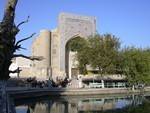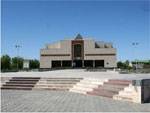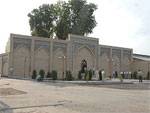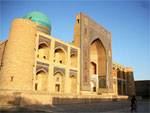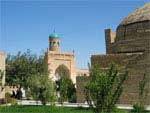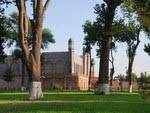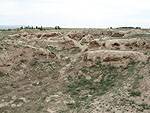Customs, traditions and way of life
The Uzbek ethnos is one of the most ancient, vivid and numerous in Central Asia. The lands in the upper reaches of Amudarya and Syrdarya and in the foothills of the Tien-Shan mountain chain were always distinguished by their ethno-cultural components from other regions of Central Asia. Local dwellers in the 4th century BC transformed from nomadic tribes to settlers in these regions. This is why at the very outset of civilization the original cultural and social structure of the society was formed here; this structure has not changed since. Only with the spread of the Islamic religion, some aspects of the Uzbek culture underwent certain changes; however, the religion nurtured the culture as opposed to subduing it.
Traditional Uzbek house
Uzbek hosts are very hospitable and show the utmost respect to guests and acquaintances alike. Uzbeks usually live in big families, shown by the one or two-storied houses that they mainly inhabit throughout the regions of Uzbekistan. Traditionally the house (often two-storied with an open veranda) is mainly built around a courtyard, which can be used to grow vegetables and fruits throughout the year. Grape vines are fixed on metallic or wooden constructions in the yard or in front of the house, which gives nice shade and shelter on a hot summer's day.
The drawing room (mehmon-khona) is the largest and most decorated room in the house. In this room, signs of hospitality can be seen immediately upon entry. The floors are covered with carpets. Kurpachas (mid-sized embroidered mattresses) cover the floor where dinners usually take place. Family members have their meals sitting on the kurpachas and at night they serve as mattresses to sleep on. Tables and chairs may also be used in dining room; beds may be used in the bedrooms. When the weather is good, a family can rest or sleep on wooden beds (topchan) out in the courtyard. If you receive an invitation for lunch, be sure to come in time. The hosts meet the respected guests at their gates, greet them, enquire about their life and business and then invite them to the house as part of the tradition. It is necessary to occupy the seat indicated by the host. Moreover, the further it is from the entrance the more respectful it is to the guest.
All meals end with a pot of tea. They usually start off with sweets, baked pastries, stewed fruits, nuts, fresh fruits and vegetables are served. Then the main course is given which is usually the obligatory pilaf (plov) with other side dishes.
Hot bread (lepeshka) is always in abundance. Be sure not to turn the bread over or to drop a piece of bread, as these are both considered bad omens.
Tea and tea drinking rituals occupy a significant place in the Uzbek life. Brewing of this principal drink of the country and pouring it into a guests' cup is an exceptional privilege for men and most of all, the hosts. Tea is brewed in small teapots and poured into small pialas (cups). A small quantity of tea poured for a guest shows respect and hospitality. The more respectful the guest is the less amount of tea is in his or her cup. This paradox is easy to explain, as the guest will ask to the host for another helping more often; thus the host will pay more attention to the guest. This can also have an adverse affect as an unwanted guest may get a cup of piping hot tea poured to the brim.
To get an idea of the real life of Uzbek people, their daily routine and to feel the hospitality and good nature of true Uzbeks, we offer you to visit a real Uzbek house. This visit will undoubtedly leave unforgettable impressions of Uzbek hospitality and the splendid Uzbek cuisine you will be treated to!
Chaikhana (tea house)
The chaikhana has the same local traditions as tea itself. It is an important part of the customs of Uzbek society. Always located in a cool, shadowy place (preferably near water spring) the chaikhana is a place to meet for social interaction, communication and brotherhood. Uzbek males gather around short tables set on topchans (wooden bed) decorated with ancient carpets; enjoy wonderful pilaf, shashlik and never-ending pialas of tea.
Tea, undoubtedly, is the national drink. It is connected with Uzbek cuisine. As the cuisine is mostly very oily, fat and heavy, green tea is obligatory after eating because it stimulates digestion and is very good for the health. Social life here is concentrated at the mosques, at the bazaars and of course in chaikhanas.
Here people communicate, negotiate, relax, eat breakfast and dinner and discuss life issues.
People select the chaikhana somewhere in a shadowy area near water, which will make the conversation tranquil and calm.
A chaikhana design is very typical - a topchan is surrounded with kurpachas covered with carpets. At the entrance of a house and chaikhana, you should take your shoes off because chaikhana's cultural significance is not less than the cultural significance of the native Uzbek house. You are always welcomed here no matter if you are a constant guest or a newcomer. You will be met with great respect and hospitality.
Public and family life
Islam plays an important role in the public and family life of Uzbeks. Religion has always determined the daily routine, everyday life, family and ideology aspects of life. It strongly influences political processes, art and tenor of life. Domestic relations are built on the basis of absolute respect to the head of the family and respect of adults in general. In local family women occupy two roles; one as a mother and wife and secondly as a subordinate of the husband and his parents. Although difficult to understand by foreigners, this is not considered discrimination, rather it is a century-old tradition based on life experience in difficult conditions.
A Muslim prays five times a day (nomaz) and during the month of Ramadan, he must fast; smoking, drinking and eating (from sunrise to sunset) is strictly prohibited. A Muslim must voluntarily deduct some of his income (zakyat) to the pour or for righteous deeds during this period. Uzbekistan is a relatively young Muslim state. Though the local existence is varied there is always space for secular life and religious tolerance.
The mahalla (local neighborhood) is one of the traditional forms of social life in Uzbekistan. It is the neighborhood community center, which offers close-knit relations between close neighbors and relatives. Assistance and help unite them. The community has its own mosque and local self-government. The significance of this social body is so great that it is acknowledged as the most important part of local self-government of the country. In sovereign Uzbekistan, the mahalla has become the keeper of cultural and moral traditions of the Uzbek people. The mahalla activities are aimed at people with low means, pensioners, handicapped people and veterans of war. This local governmental body helps people in need in any kind of situations. During national holidays, festive pilaf is made by the mahalla and any person is invited to taste it. The mahalla also provides premises and furnishings/equipment for different events, both happy and sad. People of all different nationalities live side by side in the mahalla in peace. There are more than 10 000 mahallas that embrace the entire territory of Uzbekistan. It is an important link in Uzbekistan's civil society.
Headwear (tyubeteyka)
The tyubeteyka (from Turk "tube" - top, peak) is the national headwear of the Uzbeks and other nations of Central Asia. This integral part of the Uzbek traditional costume expresses the real life of Uzbek people. Tyubeteykas differ in types: male, female, children and senior males. Elder women do not wear tyubeteykas.
Children's tyubeteykas are distinguished by variety, beauty of fabrics, embroideries, shining decorations and abundance of amulets. Four-sided, slightly rounded tyubeteykas are the most common in Uzbekistan. They are made of two or more layers of fabric which is quilted by silk and stitched with cotton thread. A ready tyubeteyka is embroidered with silk thread, golden or silver purl in color. Since ancient times Uzbek women have possessed the art of tyubeteykas embroidery. Each region creates this headwear with its own peculiar design and color. Female tyubeteykas are amazingly beautiful, embroidered with gold and luxurious ornaments. If a tyubeteyka for a girl is decorated with feathers, it means that the girl has recently got married.
There are many kinds of tyubeteykas. Chust tyubeteykas are characterized by black background and white symbols with four pods of pepper shapes on top and the brim of the tyubeteykas is embroidered with arches. Tyubeteykas of Fergana valley are simple but fascinating. Bukhara tyubeteykas are embroidered with gold. Pepper symbols (the symbol of beauty from earthly blessings), crests, feathers, nightingales, other birds (symbol of the highest wisdom), rose stems (symbol of peace and beauty) and holy Arabic inscriptions are the most spread symbols for tyubeteyka making.
Clothes
Uzbek traditional clothes have remained practically unchanged since the beginning of new era. Traditional male wear consists of warm quilted gown - chapan - tied with handkerchief as a belt. The headwear is the tyubeteyka, and the footwear (boots) is made of thin leather. Males wear straight-cut shirts, lower and upper gowns. The gowns can be light and warm. There are special cuts on the sides of the gown for comfortable walking and sitting on the floor. Usually the chapan is tied with a handkerchief. The handkerchiefs have always indicated social status of its owner (festive design, embroidered with silver badges and buckles; bags and purses show prosperity of the person wearing it). There is also a festive chapan made of special expensive fabric and embroidery and not for everyday use.
Female traditional dress consists of a functional dress with a simple cut made of khan-atlas (silk) and sharovars - wide thin pants that narrow towards the foot. Female headwear consisted of three principal elements: cap, handkerchief and turban. Female costumes differ for the occasion from everyday wear by the richness and beauty of the fabrics. Kids wear imitation traditional clothing as the adults wear. Although there are many common features, clothes of each region or tribe have their own originality expressed with special fabrics, designs and cuts.
Clothes of the Uzbeks have recently changed under the influence of European culture. Everywhere you can meet people dressed very fashionably throughout Uzbekistan. However, the famous Uzbek embroideries, traditional headwear and carpets are still in great demand in spite of European innovations.


